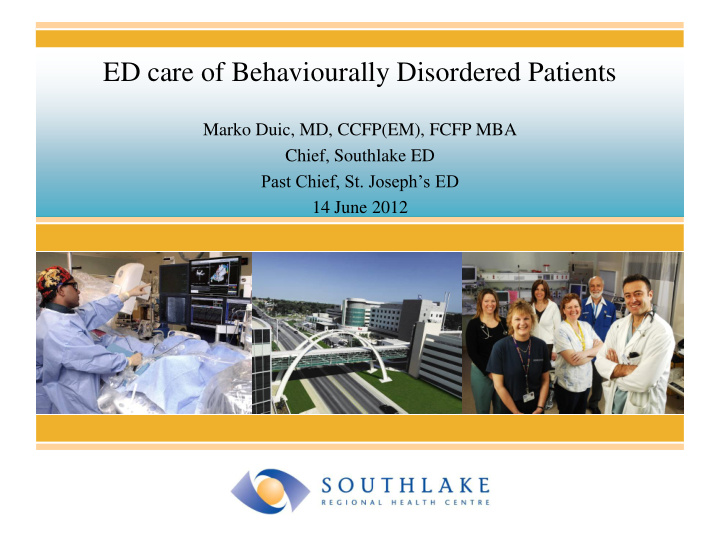



ED care of Behaviourally Disordered Patients Marko Duic, MD, CCFP(EM), FCFP MBA Chief, Southlake ED Past Chief, St. Joseph’s ED 14 June 2012
The Invitation ―We are interested in having a 20 minute presentation on the model you developed at St. Joseph’s Health Centre to improve triage of patients presenting with mental health or substance abuse issues to enhance flow and enable quick release of police officers.‖
Outline • Who is triaged to the Crisis Area? • Physical and staff description of the Crisis Area • Three examples of patient flow through Crisis Area • Statistics about – Patient types – Length of stay and admission rates • Arguing the case for a Crisis area in any large ED
Triage at St. Joseph’s • One nurse, 90 seconds, 271 patients/day • Sorts and sends to one of: – Resusc, Acute, Urgent (stretchers) – Ambulatory – Fast Track – Paeds – Crisis • Of 97,203 patients in 2011/12, – 5541 went to Crisis.
Triage to crisis Behavioural problems: • Police mental health apprehensions • Psychiatric illness exacerbations self-arrivals • Substance abuse • Delirium, dementia • Behaviour out-of-control NYD
Not triaged to crisis • Patients requiring IV, oxygen, suction • Patients unable to walk e.g. to bathroom
Crisis area inanimates • Locked, contained area • 3 seclusion rooms with special stretchers • 3 box beds • 6 pull-out chair/beds • 3 special stretchers in open curtained rooms • Unthrowable chairs and coffee table • Laundry • Crisis office • 2 interview rooms • 2 bathrooms • Clothing donation cupboards • Plexiglass nursing station • Nothing sharp, throwable, or to hang from • Cameras everywhere, central monitor
Crisis area staffing Care provision • 1 RN, 1 RPN • 24 hour security • EPs Consultation • 2 day, 1 overnight crisis worker (CW) (36h/day) • 8 hours youth crisis worker (YCW)/d • Psychiatrist on site ―16 hours‖ • No calling psychiatrist MN to 8 • Addictions Service Worker 16h/day
Process Principle: parallel processing Any of the following can see the patient in any order: • Emergency Physician • Crisis Worker • RN or RPN • Security (to lock up belongings or ensure patient has no dangerous objects) • Addictions Service Worker
Process: Example1: Patient with Alcohol Intoxication • Arrives at triage, can walk • Sent to crisis • Seen by RN + RPN, blood drawn, vitals done, put on a cot • Seen by EP routinely (90P is 1:36h) • Medical assessment done, further orders as needed, allowed to detoxify • Reassessed (RN calls an EP, usually not the same one who assessed patient earlier) • Pt discharged; CIWA’d , sent to detox, or sent to EPT (rarely)
Process: Example 2: Psychotic Patient Brought by Police • Triaged, sent to Crisis • EP called stat because pt with police • EP attends, certifies, orders restraints incl chemical • Personal effects stored, pt. observed x hours • Reassessed by (different) EP, seen by EPT/psych in any order • Admitted or discharged
Process: Example 3: Depressed Patient with Toxic Overdose • Triaged to acute stretchers (not crisis initially), seen by EP, certified; sitter • Medical issue resolved (sometimes many hours) • Sent to crisis • Seen by EPT/psych — their assessment can (occasionally) start before patient moved to crisis • Admitted or discharged
Patient types • Total ―crisis‖ patients in 11/12: 5541 • (Total patients in 11/12: 97,203) • Crisis patients seen by EPT: 2934 or 54% • Crisis patients seen by Medicine 2% • Crisis patients seen only by EPs: approx 44%
Patient types • Total ―crisis‖ patients in 11/12: 5541 • (Total patients in 11/12: 97,203) • Crisis patients seen by EPT: 2934 or 54% • Of these, brought in by Police: 37% • All EPT patients, within/outside catchment: 67/28% • Police-brought EPT patients, within/outside: 64/29% • Crisis patients seen by Medicine 2% • Crisis patients admitted 23.7% • Crisis patients seen only by EPs: approx 44%
Admission Destinations from Crisis • Total Crisis visits 5541 (of 97,203) in 2011/12 • Total Crisis admissions: 1437: 25.9% – Mental Health admissions: 1308: 91% – Medicine admissions: 91: 6.3% – ICU admissions 38: 2.6%
Length of Stay in Crisis Area 90 th percentile mean Total 12.6 hours 24.7 hours not admitted 8.7 hours 17.8 hours admitted 23.7 hours 48.9 hours
Why crisis? • SAFETY, HEALING, OTHER PATIENTS • Contained environment • MH patients need space to ambulate • Healing starts with social interaction • Other patients frightened by manifestations of psychiatric illness and substance abuse
Hospital Comparison St. Joseph’s HC Southlake Regional HC Visits/year 97,000 (266/day) 86,000 (but 95,000 currently) 11/12 Community Inner-city, poor, non-English Distant suburbs, affluent, Anglo speaking Neighbours CAMH, Parkdale, detention centres Small towns (bedroom communities and farming) % mental 5.6% (5541 of 97,203) 4.7% (4080 of 86,038) health 11/12 % of these 23.7% 36.7% admitted Overall % 11.1% 12.1% admitted Average LOS 23.7 if admitted, 8.7 if not adm Not separately broken out for crisis pts % of these 36.96% Not tracked Police MHA
OPERATIONAL SAVINGS • Cohorting these patients requires less security than in an open area • Nursing is more efficient • Less disturbance of care in other areas, fewer errors caused by interruptions • Savings on sitters • Likely significantly lower admission rate
SUMMARY • Locked, contained, safe area is the optimal environment for looking after behaviour-disordered patients • Safe for these patients e.g. no successful suicide attempts in over 10 years); safer for other patients; • Less expensive • Promotes healing — psych patients need to get up, walk around, and talk to others to heal — not possible in a conventional environment
Thanks for your attention… Questions?
Recommend
More recommend